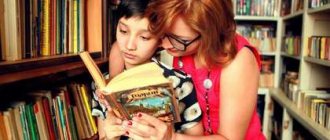Modern forms of work in the book corner with children of senior preschool age
Anna Andreeva
Modern forms of work in the book corner with children of senior preschool age
Today, various educational organizations, in particular, kindergartens, are more acutely faced with the task of introducing children to books, cultivating an interest in reading, and developing a literate reader . If in preschool age a child does not understand and does not feel that reading a good book is very interesting, then at school, when he sits down with textbooks and a computer, he will no longer love fiction.
Using literary texts as ready-made cultural material, the teacher becomes a guide for children into the worlds created by the book.
In other words, reading fiction takes the form of a partnership between an adult and children .
Sociological research in our country has revealed the following negative trends:
1. A noticeable decrease in interest in reading among primary schoolchildren and adolescents;
2. A sharp reduction in the share of reading in the structure of children’s free time due to the fact that television, video and audio equipment, computers and the Internet have practically crowded out books from their lives;
3. Substitution of genuine literature with “surrogates”
mass culture, etc.
To avoid such problems, you should start introducing your child to books as early as possible - long before he goes to school and learns to read himself. Only a book can enrich a child’s world, make it interesting, full of extraordinary discoveries and the pleasures of new knowledge. A child should love a book, reach out to it, expect a holiday of mind and soul from communicating with it.
Reading develops a person’s soul, teaches him to be compassionate, to be merciful, to feel the pain of others and to rejoice in the success of others.
Reading develops a person’s speech, makes it correct, understandable, imaginative, and beautiful.
Reading is an impulse to creative insight, to the creation of a new artistic creation.
A person who reads knows how to use information and research it. Nowadays, the ability to extract information and the ability to make decisions based on its analysis is valued as a high professional achievement.
Reading literary texts to children should be daily, not only in kindergarten, but also at home. Regular interesting reading should become a habit, become a custom, a ritual of group life.
• Time for reading should be allocated in the daily routine.
• Reading a book should take place in a relaxed atmosphere. Those who do not want to listen to a book at the moment must follow only one rule: go about their business quietly, without disturbing others.
The teacher can schedule literary texts for long-term reading for 2-3 months. Short works of fiction for short reading can be selected for a month, their selection is constantly adjusted.
The teacher himself selects literary texts suitable for the children in his group.
When reading a book, the teacher acts as a partner for the children in perceiving its content: showing emotions, surprise, amazement, compassion, etc. Monotonous reading can discourage a child from listening.
In the selection of fiction, the interaction of the kindergarten with the family is very important.
TASKS FACING PRESCHOOL EDUCATIONAL INSTITUTIONS TO PREPARE CHILDREN FOR SCHOOL:
1. To develop children’s sustainable interest in literature as an art form; to educate a competent reader;
2. Teach children to analyze the text, comprehend the meaning of what they are reading and the aesthetic nature of the text. Build knowledge about the work.
3. Monitor how children perceive a work of art, what impact it has on them, take into account the child’s opinion about the work and, if necessary, correct it, form the child’s moral potential;
4. Develop the need for daily communication with fiction, teach children to respect the book, to be aware of its role in human life;
5. Expand the range of children's reading through the introduction of modern works of fiction;
6. At the regional level, adjust the program by introducing national folklore works by writers who are native speakers of the national language;
7. Create a library in preschool educational institutions, library areas in groups; organize book exhibitions , images of new book releases , inform parents about the gaps in children's and family reading;
8. Control the family reading process;
9. Create a literary base for the implementation of the program, consisting of a music library, funds (portraits of writers, autographed books, meetings, literary festivals, etc., materials from classes with parents on children’s reading issues. Actively use what has been accumulated in working with children and parents .
One of the important tasks of preschool educational institutions is to introduce children to books and fiction. It is with acquaintance with the fascinating world of books that the formation of a full-fledged personality begins. It is impossible to instill in a child a love of literature if the adults around him do not have it. The problem is aggravated by the fact that a child who is indifferent to books lacks motivation for subsequent studies at school.
It is necessary to introduce the child to reading. Not just teach to read, but cultivate a desire to read, a desire to learn new things through communication with a book.
The corner of a book a significant role in developing preschoolers’ interest in fiction . This is a special, specially designated place where a child can independently, according to his taste, choose a book and calmly examine, “re-read”
her. Here there is an intimate, personal communication between a child and a work of art - a book and illustrations.
In the older group, children are taught to understand the motives of the actions of heroes of literary works, form a conscious attitude towards them, pay attention to the language of a fairy tale, story, the author's techniques and turns of phrase, and consolidate the skills of careful use of a book. Children receive a basic understanding of how books are created and the enormous value they have for understanding the world.
In class we conduct general discussions on the topics: “What do we know about the book”
,
“A book is your best friend”
,
“What fairy tales teach”
,
“How the book appeared”
and others. We also organize special classes dedicated to the work of individual writers and poets.
We also organize book repair workshops in groups. Children themselves select the necessary materials - paper by color and thickness, glue, etc. While working together, they remember the contents of the books and share their impressions of the actions of the heroes.
Consolidating children's knowledge of the rules for handling books, we introduce new ones:
• books can only be picked up with clean hands;
• always watch them at the table;
• do not fold the corners of the pages ;
• turn pages carefully, one at a time, slowly;
• do not use for games;
• after looking, always put the book back in its place.
When organizing work with a book, we use the following methods:
• meaning-revealing - allowing children to determine the value of emotional experiences;
• sign-symbolic;
• pantomimic sketches that stimulate self-control and self-assessment of their own emotional manifestations in preschoolers ;
• methods that model the degree of change in one’s own emotions from sadness to joy, from despondency to delight, etc.;
Modern forms of work in the book corner:
• Introducing literary material for classes the book corner
• organization and holding of thematic book exhibitions .
• children's creativity (writing fairy tales, poems)
;
• thematic book exhibitions dedicated to the work of writers and poets;
• work with parents : participation in entertaining evenings on literary works, joint writing with children ;
• creation of albums with children's illustrations based on fairy tales;
• Master class “Making a handwritten book”
- for parents
• Handwritten book competition;
• Exhibition of handwritten books;
•Creation of encyclopedias: “What do our names mean”
,
“All about animals”
based on the works of V. V. Bianchi;
• “Give a book”
;
• Evening of fairy tales using children's drawings
The work carried out in the system to introduce children to book culture produces tangible results: children know and follow the rules for handling them. We hope that this interest will grow, and we will apply all our knowledge and strength to this. After all, teaching to understand and love a book means teaching to think and feel.
Bibliography:
1. L. M. Gurovich, L. B. Beregovaya, V. I. Loginova “The Child and the Book”
;
2. M. M. Alekseeva, V. I. Yashina “Methods of speech development and teaching the native language of preschoolers ”;
3. V. V. Shilina “Reading without coercion”
;
4. N.V. Shvetsova Published on the website Day after day “Introducing preschool children to the culture of reading ”
;
5. O. I. Solovyova. “Methods of speech development and teaching the native language in kindergarten” “Enlightenment”
, M., 1966
6. Ishkinina I. V. “Developmental functions of fiction in preparing children for school”
7. Tueva I. A. Project “Hello, Pushkin!”




